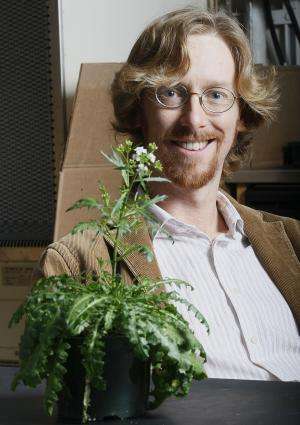Genome duplication aids plant's survival in saline soils

(Phys.org) —Having more than two sets of chromosomes can increase a plant's ability to take up nutrients and survive in saline soils, a joint study by Purdue University and the University of Aberdeen shows.
Researchers found that polyploidy, the condition of having more than two genome copies, causes the flowering plant Arabidopsis thaliana to accumulate a greater amount of potassium in its leaves and demonstrate a higher tolerance to saline environments. Most flowering plants are diploid, having two copies of a genome.
"Polyploidy has an immediate, direct influence on the accumulation of required nutrient elements in plant leaves," said Brian Dilkes, an assistant professor of horticulture and landscape architecture at Purdue. "This shows how polyploidy can play a role in plant adaptation and may explain why genomes in plants evolve the way they do."
Dilkes says the altered nutrient uptake observed in A. thaliana could hold true for other plant species.
"Many crops are already polyploids, but we can make use of these findings in a variety of species," he said. "Polyploidy could be used as a tool for expanding the range of current diploid crops. For example, it opens up a new way of manipulating plants' abilities to absorb nutrients and survive in nutrient-poor or toxic environments."
The sodium resistance of polyploids could make them valuable cultivars in regions with saline soils.
Due to its recurrence throughout plant history, polyploidy was long thought to have adaptive benefits. Most laboratory studies, however, found polyploids with four identical genome copies to be equal or weak compared with diploids. Dilkes' study demonstrates that polyploidy's positive effects depend on the environment in which polyploids are grown.
The study, led by Dai-Yin Chao of Aberdeen, is available on the website of Science Express and will appear in a printed publication of Science at a later date.
Dilkes and his fellow researchers measured 21 elements in the leaves of diploid and polyploid Arabidopsis thaliana specimens from around the world. They found that A. thaliana tetraploids - plants with four identical sets of chromosomes - had a distinct nutritional advantage over their diploid counterparts: a 32 percent greater potassium concentration in leaves.
Subsequent testing of tetraploids created in the laboratory confirmed the link between genome duplication and the accumulation of specific elements in leaves.
"When we took a variety of A. thaliana and doubled its genome content, we found that the potassium level of the leaves always went up," Dilkes said.
Plants with four genome copies also demonstrated a greater survival and reproduction rate than diploid plants when grown in a saline-supplemented environment. This could be explained by increased potassium accumulation due to polyploidy.
"Previous work has suggested that one of the critical factors in plant tolerance to a saline environment is maintaining a high potassium-to-sodium ratio," Dilkes said. "The balance of those two elements is extremely important to survival."
Polyploidy's effects also were transmitted across graft unions from the root to the shoot. When diploid A. thaliana shoots were grafted onto polyploid roots, the leaves showed an increase in potassium accumulation.
"This demonstrates that it is nutrient uptake and trafficking by the root that must be responsible for nutrient concentration in leaves," Dilkes said. "When you have a polyploid root, you end up with leaves that contain a higher amount of potassium."
Developing polyploid rootstocks for grafting could be highly valuable, Dilkes said. "You can select a saline-tolerant rootstock for a fruit tree and then graft with shoots that have other desirable characteristics."
Further research is needed to determine the exact mechanism that causes polyploids to accumulate greater amounts of potassium, Dilkes said. He also is studying whether this change in nutrient accumulation contributes to plant adaptation in the wild, which is key to understanding both short- and long-term evolution of plants.
The saline tolerance of A. thaliana polyploids could shed light on the survival and expansion of early plant species.
"Flowering plants emerged when much of the land mass on Earth was covered by a saline desert," Dilkes said. "It's possible that the rapid spread and multiplication of plant species was due to polyploids' ability to colonize new, highly toxic environments. The findings of this study provide a potential explanation for why we have observed polyploidy recurrently over the history of land plants."
More information: Polyploids Exhibit Higher Potassium Uptake and Salinity Tolerance in Arabidopsis, Science Express, 2013.
Journal information: Science Express
Provided by Purdue University
















